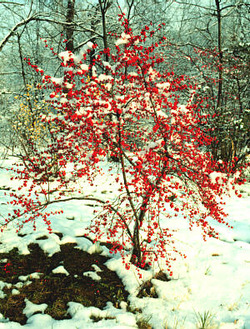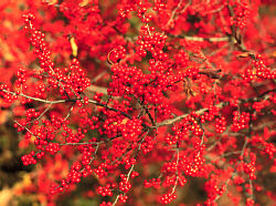
The U.S. National Arboretum presents 'Sparkleberry' holly, an improved deciduous holly for the landscape. 'Sparkleberry' produces a striking and long-lasting display of brilliant red winter berries on large plants of upright form. Planted at woodland's edge or in a massed grouping, 'Sparkleberry' will add sparkle to your landscape! 'Sparkleberry' is a female selection and requires a pollinator for good fruiting. A male selection of the same cross, Ilex 'Apollo', was released as a pollinator for 'Sparkleberry'.
Recognition: The Pennsylvania Horticultural Society Gold Medal Award, 1987.
'Sparkleberry' Holly
Botanical Name:Ilex (serrata x verticillata) 'Sparkleberry'
Family:Aquifoliaceae
Hardiness:U.S.D.A. Zone 5b - 9
Development:Deciduous hybrid female selection produced by controlled cross of Ilex serrata and I. verticillata in 1961 by William F. Kosar at the National Arboretum. Ilex 'Apollo' is a male selection of the same cross selected for its ability to provide sufficient pollen at the correct time for pollinating 'Sparkleberry'. Released 1978.
Significance:'Sparkleberry' and 'Apollo' resulted from a National Arboretum plant breeding program to develop hollies with highly ornamental qualities and improved adaptability to diverse landscape conditions. This cross of a Japanese species with a southeastern native resulted in a plant with the heavy fruiting character of the Asian parent, the larger fruit size and adaptability to wet soils of the native parent, and superior fruit retention to either parent.
Description:Height and width: 12 feet tall and wide.
Habit: Large, multi-stemmed, deciduous shrub; upright form.
Foliage: Typical of species, yellow autumn color. Male pollinator, 'Apollo' is similiar in size, habit and leaf.
Flowers: Female selection. Small white flowers in early June. 'Apollo' (male) produces abundant flowers.
Fruit: Abundant, large (5/16 inch), brilliant glossy red fruit with outstanding persistence. Fruit may persist until March. Fruit borne on short pedicels, on current season's growth. Fruit production requires male pollinator of either parent species or 'Apollo'.
Culture:Adaptable to wet or dry sites and wide range of soil types from light sandy loam to heavy clay loam and muck soils. Adaptable to sun or shade. Flowers and fruits more heavily in full sun.
Propagation:Roots easily from softwood cuttings throughout the growing season, under mist, 1000-3000 ppm IBA, in 6-8 weeks.
Landscape Use:Effective in mass plantings and suitable for large landscape areas. Highly ornamental at a woodland edge. Tolerant to air pollution, salts and wide range of soil types. Both male and female are required for fruit set.
Availability:Readily available through mail-order firms and retail and wholesale nurseries.
Recognition: The Pennsylvania Horticultural Society Gold Medal Award, 1987.
'Sparkleberry' Holly
Botanical Name:Ilex (serrata x verticillata) 'Sparkleberry'
Family:Aquifoliaceae
Hardiness:U.S.D.A. Zone 5b - 9
Development:Deciduous hybrid female selection produced by controlled cross of Ilex serrata and I. verticillata in 1961 by William F. Kosar at the National Arboretum. Ilex 'Apollo' is a male selection of the same cross selected for its ability to provide sufficient pollen at the correct time for pollinating 'Sparkleberry'. Released 1978.
Significance:'Sparkleberry' and 'Apollo' resulted from a National Arboretum plant breeding program to develop hollies with highly ornamental qualities and improved adaptability to diverse landscape conditions. This cross of a Japanese species with a southeastern native resulted in a plant with the heavy fruiting character of the Asian parent, the larger fruit size and adaptability to wet soils of the native parent, and superior fruit retention to either parent.
Description:Height and width: 12 feet tall and wide.
Habit: Large, multi-stemmed, deciduous shrub; upright form.
Foliage: Typical of species, yellow autumn color. Male pollinator, 'Apollo' is similiar in size, habit and leaf.
Flowers: Female selection. Small white flowers in early June. 'Apollo' (male) produces abundant flowers.
Fruit: Abundant, large (5/16 inch), brilliant glossy red fruit with outstanding persistence. Fruit may persist until March. Fruit borne on short pedicels, on current season's growth. Fruit production requires male pollinator of either parent species or 'Apollo'.
Culture:Adaptable to wet or dry sites and wide range of soil types from light sandy loam to heavy clay loam and muck soils. Adaptable to sun or shade. Flowers and fruits more heavily in full sun.
Propagation:Roots easily from softwood cuttings throughout the growing season, under mist, 1000-3000 ppm IBA, in 6-8 weeks.
Landscape Use:Effective in mass plantings and suitable for large landscape areas. Highly ornamental at a woodland edge. Tolerant to air pollution, salts and wide range of soil types. Both male and female are required for fruit set.
Availability:Readily available through mail-order firms and retail and wholesale nurseries.

 RSS Feed
RSS Feed
